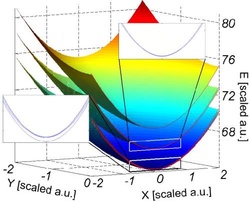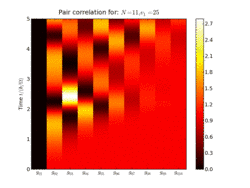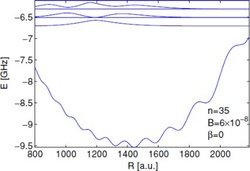Ultracold Rydberg Atoms
Introduction
Among the many fascinating systems encountered in modern ultracold atomic and molecular physics are Rydberg atoms. Rydberg atoms are (in the framework of ultracold physics almost exclusively alkali-)atoms in states of high principal quantum number n. Their size can easily exceed that of ground state atoms by several orders of magnitude. Already a state with principal quantum number n = 40 has an electronic orbit that measures 200 nm in diameter and thus is more than thousand times larger than the ground state. The associated displacement of the atomic charges makes Rydberg atoms highly susceptible to external fields and at the same time is the origin of their strong mutual interaction.
Trapping of Rydberg Atoms

Owed to their large size, Rydberg atoms do not only interact much stronger than their ground state counterparts but also behave quite differently when placed in electric and/or magnetic field configurations that provide trapping for ground state atoms. Being omnipresent in experiments dealing with ultracold atoms, inhomogeneous magnetic fields seem predestined for trapping Rydberg atoms. However, due to the high level density and the strong spectral fluctuations with spatially varying fields, trapping or manipulation in general is a more delicate task than for ground state atoms. In our group, we investigate the peculiarities that arise for trapped Rydberg atoms and analyze the implications for ultracold experiments that utilize Rydberg atoms.
Correlated Quantum Dynamics of Interacting Rydberg Systems

In ultracold gases, the strong dipole-dipole interaction has been shown theoretically and experimentally to entail a blockade mechanism thereby effectuating a collective excitation process of Rydberg atoms. We investigate such correlated excitation dynamics for finite one- or two-dimensional systems. The strong dipole-dipole interaction renders Rydberg atoms also promising candidates for the implementation of protocols realizing twoqubit quantum gates or efficient multiparticle entanglement.
Giant Rydberg Molecules

The extraordinary size of Rydberg atoms gives rise to a novel binding mechanism for a system of one Rydberg and one ground state atom. The negative scattering length between the Rydberg electron and the ground state atom entails an attractive potential for the latter at the position of the Rydberg electron. Consequently, the appearance of such giant Rydberg molecules is determined by the Rydberg electron wave function, giving rise to so-called trilobite or butterfly molecular states. We investigate how the extraordinary properties of such states can be manipulated by exposing them to external electric and/or magnetic fields. Novel molecular Rydberg states such as giant dipole molecules or Rydberg polyatomics are in the focus of our research.
